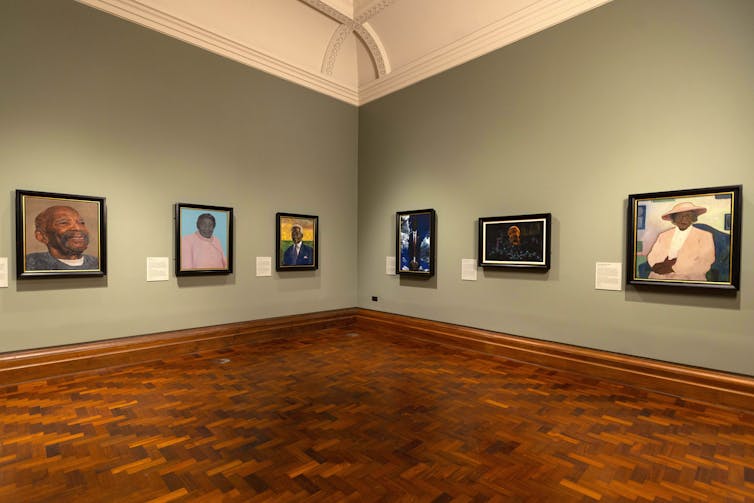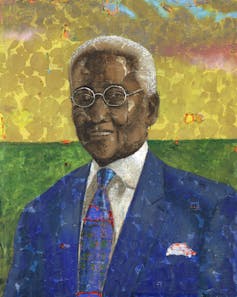Scotland’s first Black professor, Sir Godfrey Palmer, described the Windrush: Portraits of a Pioneering Generation exhibition as “an acknowledgement that we are the same people from the past … who wouldn’t have [had] our portrait put up in this way”, in a recent BBC documentary.
Palmer is one of ten people featured in the Royal Collection Trust’s exhibition, which was commissioned by King Charles III to “recognise and celebrate the immeasurable difference that they [the Windrush generation], their children and their grandchildren have made to this country”. The exhibition is on at London’s National Portrait Gallery.
The timing of the exhibition is significant. It opened less than two weeks after the home secretary Suella Braverman’s declaration that multiculturalism in Britain had “failed”. Windrush: Portraits of a Pioneering Generation suggests that Britain’s multicultural project hasn’t failed at all. If anything, these portraits – and the people they depict – hold up a mirror to a society that has underappreciated the Windrush generation for far too long.
Alongside Palmer, there are portraits of Linda Haye, the first Black woman to work in the Police Complaints Authority, Jessie Stephens, the first Black woman to work at Companies House and Alford Gardner, who served in the RAF and was one of the very first members of the Windrush generation.
‘An unyielding monument’

The exhibition is intended to be provocative. Honor Titus – the artist behind the portrait of RAF veteran Delisser Bernard, who was also part of the first HMT Empire Windrush voyage that arrived at Tilbury Docks on June 22 1948 – wants his piece to challenge the viewer. He asks: “What would being faced with an enduring figure like Delisser conjure in you?”
The portrait of Laceta Reid is similarly hard to ignore. Whereas Delisser stands above the clouds, Laceta towers higher still – above the viewer’s eyeline – cutting a gentle but imposing figure. Artist Serge Attukwei Clottey blends Laceta’s outfit into the background “to represent his adapting to where he is”.
Then there’s Sonia Boyce’s representation of Black film and television pioneer Carmen Esme Munroe. Boyce, a professor of Black art and design whose work often involves experimenting with visual media, created a digital print from a photograph of Munroe sitting in a cinema.

Perhaps the most experimental portrait of the collection – and the one which most accurately reflects where Britain currently finds itself – is Deanio X’s depiction of John “Big John” Richards. In the BBC documentary, Deanio X describes the challenge of making “something that Big John feels is familiar, resembles him … [and is] appreciated by himself and whoever he deems important”.

Deanio X uses acrylic, chalk, charcoal, graphite and ink to cast Big John as “a metaphor of an unyielding monument, unmoving in the face of rushing winds and treacherous waves”.
Richards’s granddaughter, who visits the portrait with him in the documentary, describes it as “a representation of everything he’s been through … what he’s had to overcome, and he’s still overcoming to this day”.
His portrait symbolises the troubles that the Windrush generation continue to endure. As of June 2023, four years after it was launched, only a quarter of the 6,348 applications to the Windrush compensation scheme had received their payments.
In their own image
The Windrush scandal saw thousands of British citizens wrongfully threatened with (and in 164 cases, subjected to) detention and deportation during the late 2010s. Subsequent media portrayals – such as The Guardian’s After Windrush documentary and BBC Newsnight’s recent expose on the failings of the Windrush compensation scheme – have arguably had a disempowering effect on the Windrush generation by over-identifying them as victims.

In doing so, they’ve overlooked the generation’s fundamental role in Britain’s history. The danger of a single story, as Nigerian writer Chimamanda Ngozi Adichie says in her 2009 TED Talk on the topic, is that it shows “a people as one thing, as only one thing, over and over again – and that is what they become”.
In my doctoral research, I argued that the Windrush generation should be depicted in visual arts media as “more than victims”. I gave the example of a collaborative documentary film project, Windrush: The Years After - A Community Legacy on Film (2023), where the director and production team consulted with their interviewees in terms of what the final product should look like.
The significance of a collaborative artistic process is that it allows for a more diverse set of stories and representations of the Windrush generation to emerge.

Each of the 10 artists in this exhibition spent a significant amount of time getting to know their sitters, making a meaningful effort to weave their stories into their portraits.
Derek Fordjour, for example, uses scraps of newspaper for Palmer’s portrait. He made the choice after hearing how Palmer came to the UK, aged 14, and was wrapped in newspaper for the flight by his grand aunt – so he wasn’t cold when he arrived.
Similarly, Amy Sherrald says the purpose of her portrait is to show Edna Henry through Henry’s own words, rather than her own.
In its collaborative approach, this exhibition doesn’t just present images of the Windrush generation – it reveals the people behind the paintings.

Looking for something good? Cut through the noise with a carefully curated selection of the latest releases, live events and exhibitions, straight to your inbox every fortnight, on Fridays. Sign up here.

